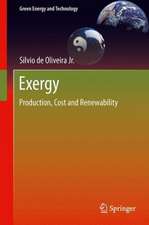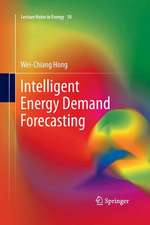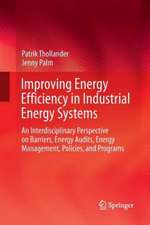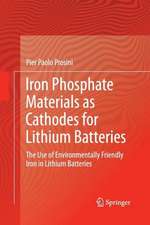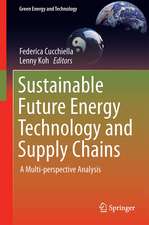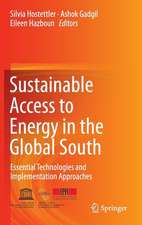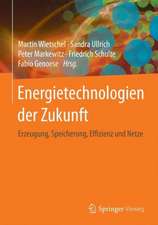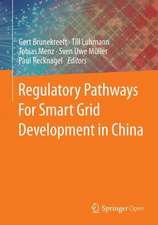Organic Solar Cells: Materials and Device Physics: Green Energy and Technology
Editat de Wallace C. H. Choyen Limba Engleză Hardback – 17 noi 2012
Addressing the important device physics issues of carrier and exciton dynamics and interface stability and novel light trapping structures, the potential for hybrid organic solar cells to provide high efficiency solar cells is examined and discussed in detail. Specific chapters covers key areas including:
Latest research and designs for highly effective polymer donors/acceptors and interface materials
Synthesis and application of highly transparent and conductive graphene
Exciton and charge dynamics for in-depth understanding of the mechanism underlying organic solar cells.
New potentials and emerging functionalities of plasmonic effects in OSCs
Interface Degradation Mechanisms in organic photovoltaics improving the entire device lifetime
Device architecture and operation mechanism of organic/ inorganic hybrid solar cells for next generation of high performance photovoltaics
This reference can be practically and theoretically applied by senior undergraduates, postgraduates, engineers, scientists, researchers, and project managers with some fundamental knowledge in organic and inorganic semiconductor materials or devices.
| Toate formatele și edițiile | Preț | Express |
|---|---|---|
| Paperback (1) | 639.25 lei 6-8 săpt. | |
| SPRINGER LONDON – 14 dec 2014 | 639.25 lei 6-8 săpt. | |
| Hardback (1) | 644.18 lei 6-8 săpt. | |
| SPRINGER LONDON – 17 noi 2012 | 644.18 lei 6-8 săpt. |
Din seria Green Energy and Technology
- 18%
 Preț: 943.43 lei
Preț: 943.43 lei - 20%
 Preț: 629.52 lei
Preț: 629.52 lei - 18%
 Preț: 1124.92 lei
Preț: 1124.92 lei - 18%
 Preț: 947.35 lei
Preț: 947.35 lei - 15%
 Preț: 655.92 lei
Preț: 655.92 lei - 18%
 Preț: 957.62 lei
Preț: 957.62 lei - 18%
 Preț: 789.52 lei
Preț: 789.52 lei - 17%
 Preț: 464.56 lei
Preț: 464.56 lei - 15%
 Preț: 645.79 lei
Preț: 645.79 lei - 18%
 Preț: 903.93 lei
Preț: 903.93 lei - 24%
 Preț: 1322.09 lei
Preț: 1322.09 lei - 18%
 Preț: 890.54 lei
Preț: 890.54 lei - 18%
 Preț: 1115.46 lei
Preț: 1115.46 lei - 18%
 Preț: 1117.03 lei
Preț: 1117.03 lei - 18%
 Preț: 949.73 lei
Preț: 949.73 lei - 18%
 Preț: 892.11 lei
Preț: 892.11 lei - 15%
 Preț: 648.24 lei
Preț: 648.24 lei - 18%
 Preț: 997.09 lei
Preț: 997.09 lei - 15%
 Preț: 579.81 lei
Preț: 579.81 lei - 18%
 Preț: 1123.15 lei
Preț: 1123.15 lei - 18%
 Preț: 961.41 lei
Preț: 961.41 lei - 17%
 Preț: 490.23 lei
Preț: 490.23 lei - 18%
 Preț: 904.60 lei
Preț: 904.60 lei - 15%
 Preț: 643.34 lei
Preț: 643.34 lei -
 Preț: 287.91 lei
Preț: 287.91 lei - 24%
 Preț: 634.05 lei
Preț: 634.05 lei -
 Preț: 379.40 lei
Preț: 379.40 lei - 18%
 Preț: 783.20 lei
Preț: 783.20 lei - 18%
 Preț: 1394.84 lei
Preț: 1394.84 lei - 18%
 Preț: 1691.57 lei
Preț: 1691.57 lei - 18%
 Preț: 1112.48 lei
Preț: 1112.48 lei - 15%
 Preț: 592.61 lei
Preț: 592.61 lei - 18%
 Preț: 952.09 lei
Preț: 952.09 lei - 18%
 Preț: 944.19 lei
Preț: 944.19 lei - 18%
 Preț: 891.33 lei
Preț: 891.33 lei - 18%
 Preț: 1252.44 lei
Preț: 1252.44 lei - 18%
 Preț: 789.52 lei
Preț: 789.52 lei - 20%
 Preț: 566.30 lei
Preț: 566.30 lei - 18%
 Preț: 1113.71 lei
Preț: 1113.71 lei - 18%
 Preț: 1114.24 lei
Preț: 1114.24 lei - 24%
 Preț: 590.60 lei
Preț: 590.60 lei - 20%
 Preț: 567.50 lei
Preț: 567.50 lei - 24%
 Preț: 907.50 lei
Preț: 907.50 lei - 18%
 Preț: 952.89 lei
Preț: 952.89 lei - 18%
 Preț: 952.89 lei
Preț: 952.89 lei - 18%
 Preț: 950.52 lei
Preț: 950.52 lei
Preț: 644.18 lei
Preț vechi: 757.85 lei
-15% Nou
Puncte Express: 966
Preț estimativ în valută:
123.30€ • 133.98$ • 103.64£
123.30€ • 133.98$ • 103.64£
Carte tipărită la comandă
Livrare economică 21 aprilie-05 mai
Preluare comenzi: 021 569.72.76
Specificații
ISBN-13: 9781447148227
ISBN-10: 1447148223
Pagini: 272
Ilustrații: VI, 266 p.
Dimensiuni: 155 x 235 x 20 mm
Greutate: 0.52 kg
Ediția:2013
Editura: SPRINGER LONDON
Colecția Springer
Seria Green Energy and Technology
Locul publicării:London, United Kingdom
ISBN-10: 1447148223
Pagini: 272
Ilustrații: VI, 266 p.
Dimensiuni: 155 x 235 x 20 mm
Greutate: 0.52 kg
Ediția:2013
Editura: SPRINGER LONDON
Colecția Springer
Seria Green Energy and Technology
Locul publicării:London, United Kingdom
Public țintă
ResearchCuprins
Preface.- 1.Introduction to Organic Solar Cells.- 2.Active layer materials for organic solar cells.- 3.Interface Engineering for High Performance Bulk-Heterojunction Polymeric Solar Cells.- 4.Graphene for Transparent Electrodes and Organic Electronic Devices.- 5.Exciton and Charge Dynamics in Polymer Solar Cells Studied by Transient Absorption Spectroscopy.- 6.Interface Stability of Polymer and Small-Molecule Organic Photovoltaics: Degradation Mechanisms, Characterization Techniques, and Improvement Approaches.- 7.Theoretical Studies of Plasmonic Effects in Organic Solar Cells.- 8.Experimental Studies of Plasmonic Nanoparticle Effects on Organic Solar Cells.- 9.Hybrid solar cells with polymer and inorganic nanocrystals.
Notă biografică
Wallace C. H. Choy received his PhD Degree in Electronic Engineering from the University of Surrey, UK. His work at Surrey was supported by the Croucher Foundation Scholarship. He then joined National Research Council of Canada as a member of research staff to work on optical device structures of polarization independent optical amplifiers and modulators. He joined Fujitsu at San Jose, US in 2001 to develop real-time wavelength tunable lasers. He is now an associate professor of Department of Electrical and Electronic Engineering, the University of Hong Kong (HKU). His current research interests are concerned with organic optoelectronic devices and nano-material devices. Dr. Choy has published over 100 internationally technical journal papers, contributed to two book chapters and US patents. He received Outstanding Achievement Award from National Research Council of Canada in 2001 and overseas visiting fellowships from HKU to take a sabbatical leave at George Malliaras's Group, Cornell University in 2008, visits to Prof. Yang Yang, UCLA in the summer of 2009 and 2011, a visit to Prof. Karl Leo, Institut fuer Angewandte Photophysik (IAPP), Technische Universitaet Dresden, Germany in the summer of 2010, as well as Prof. Hong and Prof. Kido, Yamagata University, Japan in the summer of 2012 He has been serving a technical consultant of HK-Ulvac (a member of stock-listed Ulvac Corp) since 2005. He has delivered invited talks and served as a committee member in internationally industrial and academic conferences organized by various organizations such as IEEE, OSA and Plastic Electronics Foundation. He is now a senior member of IEEE, CEng and Member IET.
Textul de pe ultima copertă
Organic solar cells have emerged as new promising photovoltaic devices due to their potential applications in large area, printable and flexible solar panels. Organic Solar Cells: Materials and Device Physics offers an updated review on the topics covering the synthesis, properties and applications of new materials for various critical roles in devices from electrodes, interface and carrier transport materials, to the active layer composed of donors and acceptors.
Addressing the important device physics issues of carrier and exciton dynamics and interface stability and novel light trapping structures, the potential for hybrid organic solar cells to provide high efficiency solar cells is examined and discussed in detail. Specific chapters covers key areas including:
· Latest research and designs for highly effective polymer donors/acceptors and interface materials
· Synthesis and application of highly transparent and conductive graphene
· Exciton and charge dynamics for in-depth understanding of the mechanism underlying organic solar cells.
· New potentials and emerging functionalities of plasmonic effects in OSCs
· Interface Degradation Mechanisms in organic photovoltaics improving the
entire device lifetime
· Device architecture and operation mechanism of organic/ inorganic hybrid solar cells for next generation of high performance photovoltaics
This reference can be practically and theoretically applied by senior undergraduates, postgraduates, engineers, scientists, researchers, and project managers with some fundamental knowledge in organic and inorganic semiconductor materials or devices.
Addressing the important device physics issues of carrier and exciton dynamics and interface stability and novel light trapping structures, the potential for hybrid organic solar cells to provide high efficiency solar cells is examined and discussed in detail. Specific chapters covers key areas including:
· Latest research and designs for highly effective polymer donors/acceptors and interface materials
· Synthesis and application of highly transparent and conductive graphene
· Exciton and charge dynamics for in-depth understanding of the mechanism underlying organic solar cells.
· New potentials and emerging functionalities of plasmonic effects in OSCs
· Interface Degradation Mechanisms in organic photovoltaics improving the
entire device lifetime
· Device architecture and operation mechanism of organic/ inorganic hybrid solar cells for next generation of high performance photovoltaics
This reference can be practically and theoretically applied by senior undergraduates, postgraduates, engineers, scientists, researchers, and project managers with some fundamental knowledge in organic and inorganic semiconductor materials or devices.
Caracteristici
Offers updated review on topics covering the synthesis and properties of new materials for various critical roles in devices from electrodes, interface and carrier transport materials, to the active layer composed of donors and acceptors Discusses the use of novel light trapping structures and hybrid organic solar cells for realizing high efficiency solar cells Addresses important device physics issues of carrier and exciton dynamics and interface stability Includes supplementary material: sn.pub/extras






